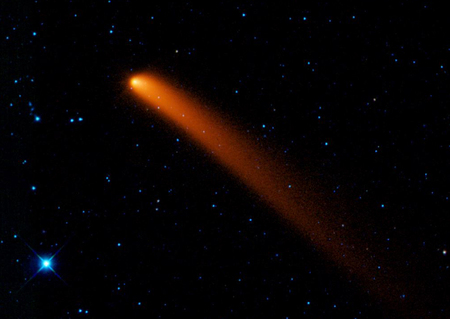WISE Infrared View of Comet Siding Spring

Creator: Wide-field Infrared Survey Explorer, Berkeley, CA, USA
Comet Siding Spring appears to streak across the sky like a superhero in this new infrared image from NASA's Wide-field Infrared Survey Explorer, or WISE. The comet, also known as C/2007 Q3, was discovered in 2007 by observers in Australia.
The snowball-like mass of ice and dust spent billions of years orbiting in the deep freeze of the Oort Cloud, a spherical cloud of comets surrounding our solar system. At some point, it got knocked out of this orbit and onto a course that brings it closer to the Sun. On October 7, 2009, it passed as close as 1.2 astronomical units from Earth and 2.25 astronomical units from the Sun (an astronomical unit is the distance between the Sun and Earth). Now, the comet is leaving the warmer, more hospitable neighborhood of the solar system and heading back out to chillier parts.
In this view, longer wavelengths of infrared light are red and shorter wavelengths are blue. The comet appears red because it is more than ten times colder than the surrounding stars, for example, the bright blue star in the foreground. Colder objects give off more of their light at longer wavelengths. An ice cube, for example, pours out a larger fraction of its light at longer infrared wavelengths than a cup of hot tea emits.
A comet like this one can be thought of as a time capsule leftover from the formation of our solar system 4.5 billion years ago. After spending most of its long, lonely life in the darkest, coldest parts of our solar system, it warms up as it approaches the Sun. The sunlight causes it to shed ices and dust in a long tail that trails behind it.
Comet Siding Spring, having experienced this "spring" awakening, is glowing in infrared light that WISE can see. Once it moves too far from the Sun's warmth and light, it will disappear from view for the foreseeable future.
Astronomers will use these measurements to learn about the comet's size, composition, reflectivity, and the size and makeup of the dust particles in its coma (the hazy cloud surrounding its nucleus) and its tail. WISE data on this and other comets will help unlock clues that lay within these icy time capsules, teaching us about our solar system's evolution.
In this image, 3.4-micron light is colored blue; 4.6-micron light is green; 12-micron light is orange; and 22-micron light is red. It was taken on Jan. 10, 2010.
Image Use Policy: Pulic Domain
View Options
Image Details
- Image Type
- Observation
- Object Name
- Comet Siding Spring • C/2007 Q3
- Subject - Solar System
- Interplanetary Body » Comet
Color Mapping
| Telescope | Spectral Band | Wavelength | |
|---|---|---|---|

|
WISE | Infrared (Near-IR) | 3.4 µm |

|
WISE | Infrared (Near-IR) | 4.6 µm |

|
WISE | Infrared (Mid-IR) | 12.0 µm |

|
WISE | Infrared (Mid-IR) | 22.0 µm |






